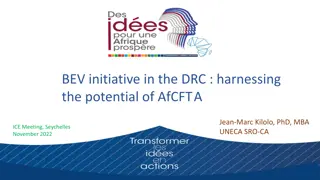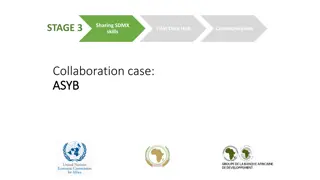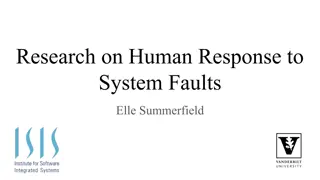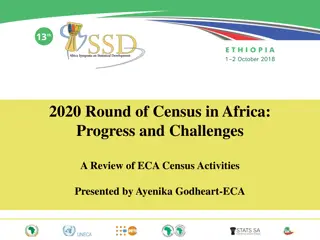
RHIC Projections and Proposed Experiments for 2014-2015 Run Period
Explore the projected experiments at RHIC, including longitudinal and transverse polarized proton-proton collisions, polarized proton-nucleus studies, and more developments outlined in talks and documents for 2014-2015. Key initiatives include increasing statistics on jet measurements, measuring sea-quark Sivers effects, and exploring diffractive production phenomena.
Download Presentation

Please find below an Image/Link to download the presentation.
The content on the website is provided AS IS for your information and personal use only. It may not be sold, licensed, or shared on other websites without obtaining consent from the author. If you encounter any issues during the download, it is possible that the publisher has removed the file from their server.
You are allowed to download the files provided on this website for personal or commercial use, subject to the condition that they are used lawfully. All files are the property of their respective owners.
The content on the website is provided AS IS for your information and personal use only. It may not be sold, licensed, or shared on other websites without obtaining consent from the author.
E N D
Presentation Transcript
http://www.rhichome.bnl.gov/RHIC/Runs/RhicProjections.pdf polarisation: 60% 250 GeV: lets assume dynamic * works can gain 2x lumi per 2013 fill impact of no 500 GeV running between 2013 and 2016 unknown Other Info: Talk by Wolfram: http://www.star.bnl.gov/~eca/pp-pA-LoI/2014-0321%20p+p%20and%20p+Au%20in%202020+.pptx Lumi-Document: http://www.star.bnl.gov/~eca/pp-pA-LoI/pp.pA.Lumi.2020+V2.docx 2 BUR-16&16, April 2014 E.C. Aschenauer
Run 9+11+12+13 Ws Run 9+11+12+13+15 jets + di-jets Run 15+16 and the nice results from 11 & 12 Proposed in 2014-2015 BUR 3 BUR-16&16, April 2014 E.C. Aschenauer
200 GeV longitudinal polarized pp increase statistics on ALL jets and di-jets at mid rapidity explore ALL in FMS 200 GeV transverse polarised pp understand the underlying physics of forward AN o direct AN; ANfor diffractive and rapidity gap events o improve statistics on AN( 0, ) ) o improve statistics on all mid-rapidity Sivers, IFF and Collins observables o central and forward diffractive production in p( )p, p( )A o elastic scattering in p( )p( ) 200 GeV transverse polarised pA study saturation effects first measurement of gA(x,Q2) and gA(x,Q2,b) through direct photon and UPC J/ unravel the underlying subprocess by measuring AN( 0 ) study GPDs trough exclusive J/ AND much more reach high ptwith good statistics 4 BUR-16&16, April 2014 E.C. Aschenauer
Run-15 needs to provide comparison data for HFT program MTD comparison data can also be collected at 500 GeV pp Following Hardware needs to be in place FMS refurbishment is going well Preshower on track design finalized LoI meetings pp2pp have problems with funding and schedule at the moment, pushing to sort it out presentations in pp-pA- 5 BUR-16&16, April 2014 E.C. Aschenauer
22 weeks running suggestion split between AuAu transverse polarized pp running at 500 GeV o Goal measure increase statistics for Sivers and Collins jet measurements in mid-rapidity measure sea-quark sivers, pin down TMD-evolution and try to resolve NSAC HP13 HFT, MTD HOW? measure simultaneously ANfor , W+/-Z0, DY DY and W+/-Z0 give Q2 evolution W+/-give sea-quark sivers All three ANfor , W+/-Z0, DY give sign change 6 BUR-16&16, April 2014 E.C. Aschenauer
Z. Kang et al. arXiv:1401.5078v1 0 < pT3 GeV 4 < Q < 9 GeV 0 < pT1 GeV Q2= 2.4 GeV2 sea quarks completely unconstrained impacts AN(DY,W , Z0, ) new calculations for AN(Z0, ) coming and maximized sea-quarks 7 BUR-16&16, April 2014 E.C. Aschenauer
Details: https://drupal.star.bnl.gov/STAR/system/files/2014-01-11_DrellYan.pptx Requirements: Drell-Yan needs ~107-106 suppression of hadron pairs o Forward rapidity naturally suppresses QCD background o Track multiplicities are small with reasonable hadron rejection o charge identification is mainly helping a small minv<2 GeV/c2 Transverse asymmetries need h>2 Background asymmetries a problem if S/B~1 Mapping out 4< minv<9 GeV/c2 needs a recorded lumi of 1 fb-1 rejections per track: scales with 1/polarization !!! Lint= 1fb-1 FMS just building one can be replaced by postshower use FMSPS technology possible till run 16 tracking: charge separation: 2 E.C. Aschenauer 8 BUR-16&16, April 2014
Proof of principle from Run-15 200 GeV data: 500 GeV need to reach same high xfas at 200 GeV bigger background from merged 0 FMS Preshower need to help to separate merged 0from single Can be done check out: https://drupal.star.bnl.gov/STAR/system/files/2014-03_28_FMS.preshower.pdf s = 200 GeV dashed curve is the direct asymmetry ANdir, dotted curve is the fragmentation asymmetry ANfrag, solid curve is the overall spin asymmetry. The different colors represent different assumptions about the magnitude of the Sivers asymmetry Old paper by Z. Kang no evolution 9 BUR-16&16, April 2014 E.C. Aschenauer
Run-15: follow last years BUR of course improve plots, arguments and so on with what we have learned in the last year Run-16: transverse polarized pp at 500 GeV need delivered Lumi: 600 800 pb-1but with cleaner TPC performance less pile up push CAD to make the dynamic * squeeze working 10 BUR-16&16, April 2014 E.C. Aschenauer
BACKUP 11 BUR-16&16, April 2014 E.C. Aschenauer
critical test for our understanding of TMDs and TMD factorization Twist-3 formalism predicts the same DIS: pp: QCD: q-scattering attractive FSI qqbar-anhilation repulsive ISI SiversDIS= - SiversDYor SiversWor SiversZ0 AN(direct photon) measures the sign change through Twist-3 All can be measured in one 500 GeV Run 12 BUR-16&16, April 2014 E.C. Aschenauer
Recorded PHENIX / 0.35 pb-1 0.12 pb-1 3.4 pb-1 7.5 pb-1 0.08 pb-1 10 pb-1 14 pb-1 27.5 / 9.5pb-1 30 / 15 pb-1 Recorded STAR 0.3 pb-1 0.3 pb-1 0.4 pb-1 3.1 pb-1 6.8 pb-1 Year s [GeV] 200 200 200 200 200 62.4 500 200 500 500 Pol [%] 15 27 40 49 57 48 39 55 48 50/54 2002 (Run 2) 2003 (Run 3) 2004 (Run 4) 2005 (Run 5) 2006 (Run 6) 2006 (Run 6) 2009 (Run9) 2009 (Run9) 2011 (Run11) 2012 (Run12) 10 pb-1 25 pb-1 12 pb-1 82 pb-1 13 BUR-16&16, April 2014 E.C. Aschenauer
Recorded PHENIX 0.15 pb-1 / 0.16 pb-1 2.7 pb-1 0.02 pb-1 5.2 pb-1 / 9.2/4.3 pb-1 Recorded STAR 0.15 pb-1 0.25 pb-1 0.1 pb-1 8.5 pb-1 Year s [GeV] 200 200 200 200 62.4 200 500 200 Pol [%] 15 30 47 57 53 45 48 61/58 2001 (Run 2) 2003 (Run 3) 2005 (Run 5) 2006 (Run 6) 2006 (Run 6) 2008 (Run8) 2011 (Run11) 2012 (Run12) 7.8 pb-1 25 pb-1 22 pb-1 14 BUR-16&16, April 2014 E.C. Aschenauer
Key measurements for polarized pp scattering deliverables observables what we learn requirements comments/competition Do TMD factorization proofs hold. Are the assumptions of ISI and FSI color interactions in pQCD are attractive and repulsive, respectively correct high luminosity trans pol pp at s=500 GeV DY: needs instrumentation to suppress QCD backgr. by 106at 3<y<4 HP13 (2015) AN DY: >=2020 might be to late in view of COMPASS ANW,Z: can be done earlier, i.e. 2016 Test unique QCD predictions for relations between single- transverse spin phenomena in p-p scattering and those observed in deep-inelastic lepton scattering. ANfor , W+/-,Z0, DY the origin of the big ANat high xfand y is a legacy of pp and can only be solved in pp what are the minimal observables needed to separate different underlying subprocesses high luminosity trans pol pp at s=200 GeV, (500 GeV jets ?) He-3: 2 more snakes; He-3 polarimetry; full Phase-II RP ANfor charged identified(?) hadrons, jets and diffractive events in pp and pHe-3 underlying subprocess causing the big ANat high xfand y HP13 (2015) and flavor separation TMD evolution and transversity at high x IFF and AUT for collins observables, i.e. hadron in jet modulations ATTfor DY how does our kinematic reach at high x compare with Jlab12 ATTunique to RHIC high luminosity trans pol pp at s=200 GeV & 500 GeV transversity and collins FF cleanest probe, sea quarks high luminosity long. pol pp at s=500 GeV Forward instrumentation which allows to measure jets and hyperons. Instrumentation to measure the relative luminosity to very high precision g(x) at small x ALLfor jets, di-jets, h/ -jets at rapidities > 1 flavour separated helicity PDFs polarization dependent FF eRHIC will do this cleaner and with a wider kinematic coverage s(x) and does polarization effect fragmentation DLLfor hyperons PWA of the invariant mass spectrum in pp p MXp in central exclusive production Searches for a gluonic bound state in central exclusive diffraction in pp high luminosity pp at s=200 GeV & 500 GeV full Phase-II RP how does this program compare to Belle-II & PANDA can exotics, i.e. glue balls, be seen in pp 15 BUR-16&16, April 2014 E.C. Aschenauer
Key measurements for pA scattering deliverables observables what we learn requirements comments/competition LHC and inclusive DIS in eA eA: clean parton kinematics LHC wider/different kinematic reach; NA61 DM8 (2012) determine low-x gluon densities via p(d) A direct photon potentially correlations, i.e. photon-jet initial state g(x) for AA-collisions A-scan LHC and exclusive VM production in eA eA: clean parton kinematics LHC wider/different kinematic reach c.s. as fct. of t for VM production in UPC (pA or AA) initial state g(x,b) for AA-collisions impact parameter dependent g(x,b) high luminosity, clean UPC trigger is the initial state for AA collisions saturated di-hadron correlations, -jet, h-jet & NLO DY, diffraction capability to measure many observables precisely large rapidity coverage to very forward rapidities polarized pA A scan complementary to eA, tests universality between pA and eA saturation physics measurement of the different gluon distributions CNM vs. WW pT broadening for J/ & DY -> Qs RpAfor many different final states K0, p, K, D0, J/ , .. as fct of rapidity and collision geometry is fragmentation modified in CNM heavy quarks vs. light quarks in CNM A scan separation of initial and final state effects only possible in eA CNM effects to tag charm in forward direction -vertex long range rapidty correlations ridge two-particle correlation at large pseudo-rapidity interesting to see the s dependence of this effect compared to LHC do these correlations also exist in pA as in AA tracking and calorimetry to very high rapidities is GPD Egdifferent from zero AUTfor J/ through UPC Ap GPD Egis responsible for Lg first glimpse unique to RHIC till EIC turns on underlying subprocess for AN( 0) resolving a legacy in transversely polarized pp collisions good 0and underlying subprocess for AN( 0) reconstruction at forward rapidities ANfor 0and 16 BUR-16&16, April 2014 sensitivity to Qs E.C. Aschenauer






















